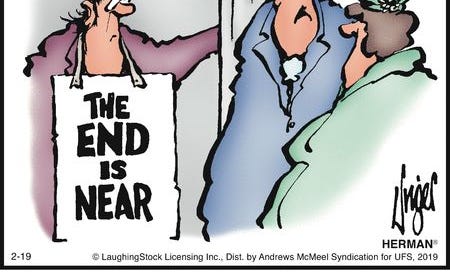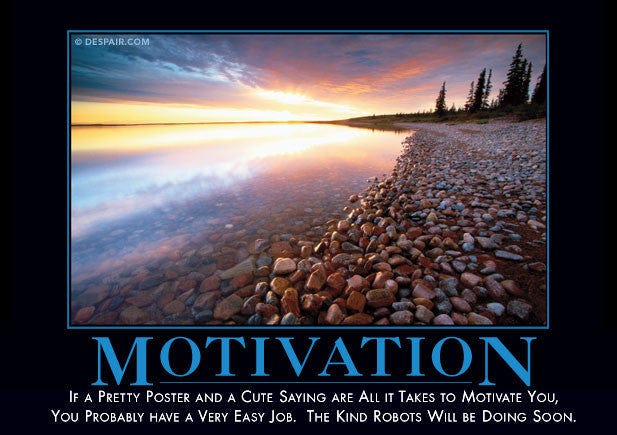10. Eliminate slogans, exhortations, and targets for the work force. Eliminate targets, slogans, exhortations, posters, for the work force that urge them to increase productivity. “Your work is your self-portrait. Would you sign it?” No—not when you give me defective canvas to work with, paint not suited to the job, brushes worn out, so that I can not call it my work. Posters and slogans like these never helped anyone to do a better job.
Deming, W. Edwards. Out of the Crisis (MIT Press) (p. 65).
What is wrong with posters and exhortations? They are directed at the wrong people. They arise from management’s supposition that the production workers could, by putting their backs into the job, accomplish zero defects, improve quality, improve productivity, and all else that is desirable. The charts and posters take no account of the fact that most of the trouble comes from the system…
Exhortations and posters generate frustration and resentment. They advertise to the production worker that the management are unaware of the barriers to pride of workmanship…
The immediate effect of a campaign of posters, exhortations, and pledges may well be some fleeting improvement of quality and productivity, the effect of elimination of some obvious special causes. In time, improvement ceases or even reverses. The campaign is eventually recognized as a hoax. The management needs to learn that the main responsibility is theirs from now on to improve the system, and, of course, to remove any special causes detected by statistical methods.
Deming, W. Edwards. Out of the Crisis (MIT Press) (p. 66-67).
4a. You have a slogan, posted everywhere, urging everyone to do perfect work, nothing else. I wonder how anyone could live up to it. By every man doing his job better? How can he, when he has no way to know what his job is, nor how to do it better? How can he, when he is handicapped by defective materials, change of supply, machines out of order? Exhortations and platitudes are not very effective instruments of improvement in today’s fierce competition, where a company must compete across national boundaries.
Deming, W. Edwards. Out of the Crisis (MIT Press) (p. 402).
THE AIM of today’s post is to review Dr. Deming’s advice against the use of posters, slogans, exhortations as a tool for managing the improvement of quality and productivity. This anti-pattern was most famously demonstrated in the antics of the hapless foreman in Deming’s own Red Bead Experiment who would comically harass and harangue the six willing workers with passive-aggressive posters and comments while oblivious to the red beads in the bucket that they needed to avoid delivering. It’s also still prevalent in workplaces today and remains a common tool to motivate or change behaviours of people.
Why Are Slogans and Posters Problematic?
In The New Economics, Dr. Deming makes a sardonic point by asking what the results on a national referendum on the improvement of quality everywhere would be, yay or nay? An easy prediction could be made in favour, who would vote otherwise? Not only that, there would be a nearly-endless list of wrong ways to go about achieving it, from more computers and automation to rating and ranking people and holding them accountable to work standards, incentive pay and motivation programs.
Why wrong? As Deming observed: “Because every one of them ducks the responsibility of management. They require only skills, not minds.” (Neave, Dr. Henry. The Deming Dimension. (p. 253) SPC Press. They also blissfully ignore the effect of the system itself, which can account for the vast majority of issues — up to 97% or more, as Deming would observe toward the end of his career.
Posters, slogans, and exhortations are similar attempts to substitute a flimsy device for leadership when the opposite is required. When you think on them, they are comically beside the point, yet we still use them and sometimes in ways that are more subtle than an in-your-face passive-aggressive dig at someone’s competence - sometimes, they are pointless platitudes or altruistic statements about what we’d like to see in our organization, but without the effort required to implement them.
An example from a past engagement comes to mind where the meeting rooms and hallways at the customer site were adorned with awkwardly-worded phrases reminding employees of their values, some of which came through recent surveys of employees and managers. The exercise was likely intended as a morale boosting activity to encourage and motivate higher productivity and quality, but came off a bit patronizing, at least to my eyes:
“We embrace and initiate change.”
“We have the courage to innovate.”
“We have a passion for growth.”
“We learn from customer feedback and take action to get better every day.”
“We are friendly, helpful, and thoughtful.”
The first is a whopper because it wasn’t really accessible by the rank and file who had few degrees of freedom to change things, the second was a bit tongue-in-cheek as there was palpable fear within the organization on a number of fronts, the third is a platitude that could be taken a number of ways, the fourth is a banality, and the last was only true insofar as their culture would permit outside of the proximity to a performance appraisal. In sum, they were aspirational statements which, if they truly described qualities of the system wouldn’t need to be gathered with a survey and printed on the walls: They would be self-evident in the quality of interactions between people and in the products and services they made.
Another more egregious example was provided to me a while ago about a member of a senior leadership team who would make their own motivational posters on the company color printer which they would then put into cheap dollar store frames and hang on walls around the office. It’s not difficult to imagine their theory of management or what they thought of their employees, or what the employees thought of them.
A Subtle Variation: Maxims
Deming’s 10th Point is particularly directed at the use of empty phrases on employees to compensate for gaps in the system with respect to quality, however there is a subtle variation on this theme that I’ve observed over my career that comes in the form of maxims or statements that are intended to convey a general truth or mode of conduct in an organization, eg. “actions speak louder than words”, “better safe than sorry”, “going the extra mile”, or even one I’ve mentioned a number of times, “a stitch in time saves nine”. Unless the maxim is paired with responses to the questions of “How? By what method? In what context?” it can come across just as poorly (and passive-aggressively) as an empty slogan.
What Could We Do, Instead?
In his typical style, Dr. Deming suggests redirecting our efforts away from motivating individuals and toward making system improvements together:
Instead, display accomplishments of the management in respect to assistance to employees to improve their performance. People need information about what the management is doing on these 14 points.
Deming, W. Edwards. Out of the Crisis (MIT Press) (p. 202). The MIT Press. Kindle Edition.
Accordingly, as Deming points out in The New Economics, if we discover someone is outside of the system, it’s our responsibility to understand why and to help them. This requires more than a passing knowledge about what’s important to them, and there’s no real shortcut for this that a poster, slogan, or maxim can cover.
Reflection Questions
In what ways have you observed posters, slogans, or exhortations being used to cover for gaps in management knowledge and the organizational system? What were the consequences? Have you worked in an organization that would indulge in this behaviour? What was the general attitude of the rank and file toward them? Management?
In what ways have you observed posters, slogans, or exhortations working? Was the effect sustained? For how long? To what would you attribute the outcome? What alternative approaches were tried? Did they involve system improvements or local optimizations?
How would you design a “motivational poster” that would encourage collaborative system improvements? What commensurate changes would need to be made to the organizational system? What would need to happen first?






